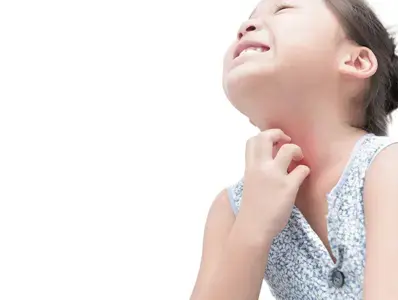Interview with Dr. Alfred Tam - Allergy in infants and young children: The situation in Hong Kong

Allergy is a frequently reported health condition among children with a globally rising trend, and allergic symptoms are considered as common manifestations reported by pediatric patients and/or caregivers regularly managed by healthcare professionals. In this exclusive interview, Dr. Tam shares with Wyeth Nutrition Science Center (WNSC) Hong Kong his clinical experiences from the Celeste Child Health Centre at Canossa Hospital in managing pediatric cases with allergic symptoms, as well as provides an overview of the local situation on allergy among infants and young children within Hong Kong.
- Special cases of childhood allergy with indefinite clinical symptoms
- Complementary feeding - A window of opportunity for inducing tolerance

Dr. Alfred Tam
Celeste Child Health Centre,
Canossa Hospital (Caritas)
Specialist in Paediatric Respiratory Medicine
Clinical Associate Professor (Hon.),
The University of Hong Kong
MBBS (HK), FRCP (Edin.,Lond.,Glasg),
FHKCPaed, FHKAM (Paediatrics)
- What are the common clinical allergic symptoms in local infants and young children?
- What are some special cases of childhood allergy with indefinite clinical symptoms?
- Evidence-based scientific approaches for allergy prevention in early stage
- Complementary feeding - A window of opportunity for inducing tolerance
- 4 Practical tips recommended by Dr. Tam for healthcare professionals dealing with allergy issues in infants and young children
What are the common clinical allergic symptoms in local infants and young children?
Of the many common clinical symptoms reported by mothers and/or caregivers concerning allergies, Dr. Tam thinks that rash is the most common complaint. Among the rashes, of more significance is seborrheic dermatitis and eczema. Seborrheic dermatitis is perhaps one of the most reported symptoms in newborns during the first 2 months of life, characterized by skin rash, redness and greasy appearance over the face and scalp. While such condition usually clears up on its own, “seborrheic dermatitis may continue into eczema, and could often be seen in infants of 3 to 6 months old with symptoms extending to all over the body including the creases of elbows and knees,” he explained. While seborrheic dermatitis is often not a manifestation of allergy, eczema is regarded as one of the hallmarks of atopy.
“Dual allergen exposures in terms of diet (especially cow’s milk proteins) and the environment are the major cause of allergic manifestations, especially among formula-fed infants.”
While allergic manifestations may be triggered by direct dietary and environmental exposures, it has also been reported that gastrointestinal symptoms such as bloody stool or loose stool may result from cow’s milk (formula) ingestion. Cow’s milk allergy may also occasionally present in breastfed babies if a small amount of formula is ingested, or the mother ingests a lot of dairy products. As such, Dr. Tam suggested the importance of being investigative in diagnostic methods when trying to identify an underlying problem.
Dr. Tam also shared with us some facts and figures on common allergies in Hong Kong:
| Quick facts – Approximate childhood allergy prevalence in Hong Kong: | |
|---|---|
| Allergic rhinitis: 15-30% | Eczema: 10-15% |
| Asthma: 10% | Food allergy: 3-5% |
What are some special cases of childhood allergy with indefinite clinical symptoms?
Case #1 - Poor growth or failure-to-thrive
Some children above 1 year old with cow’s milk protein allergy may have poor appetite with variable bowel habits such as fluctuating occurrence of both diarrhea and constipation.
Management strategies: Avoid cow’s milk protein from diet while ensure adequate nutrient intake with calcium supplementation when appropriate.
Case #2 - Allergy coupled with immune deficiency
Rarely, eczema that is difficult to treat, or is associated with persistent or recurrent infections may in fact be part of an immune deficiency. Careful investigations looking at immunoglobulin levels including IgG subclasses, T cell functions, and vaccine induced specific antibodies will point to the diagnosis.
Management strategies: Depending on the types of immune deficiency, this may range from replacement therapy to bone marrow transplant. Vaccinations will have to be specially considered.
“Multidisciplinary assessments from constitutional, metabolic, acute infection and gastrointestinal aspects may be required to identify allergy with indefinite clinical symptoms.”
Evidence - based scientific approaches for allergy prevention in early stage
Prenatal
Mothers should maintain a balanced diet with adequate multivitamin intake to support a healthy pregnancy.
Supplementations of probiotics and omega-3 polyunsaturated fatty acids have been shown to be effective in several studies, yet more large-scale interventions are warranted before consensus can be reached.
Postnatal
Adopt exclusive breastfeeding for the first 4 to 6 months of life, as breastfeeding also conveys other benefits to both the mother and the baby.
For high-risk infants with a family history of allergy who cannot be breastfed, partially hydrolyzed formula was shown in one study to be effective in reducing the risk of developing eczema1, yet the results were not replicable in other studies. Presently no definitive recommendations can be made.
“For healthy infants without a family history of allergy, preventive measures are generally not necessary, due to the lack of clinical effectiveness on allergy prevention in this group.”
Complementary feeding-A window of opportunity for inducing tolerance
While traditionally, many advice have been on food avoidance in managing and preventing food allergies, newer scientific guidelines are suggesting the contrary. In fact, “complementary foods may be introduced after 4 months old, and must be started by 6 months of age,” Dr. Tam said. There is a critical period or window when the immune system learns to cope with food allergens. Delayed introduction of solids may therefore lead to allergy development in the future.
According to the position paper published by the European Society for Paediatric Gastroenterology, Hepatology, and Nutrition (ESPGHAN) in 2017, it reinforced complementary foods should not be introduced before 4 months, but also should not be delayed beyond 6 months old. The new advocate suggests allergenic foods such as peanuts and gluten should not require delayed introductions and may be introduced alongside complementary feeding after 4 months2. Dr. Tam mentioned that cultural differences between Asian and Western countries in terms of cooking method and the types of food being introduced during complementary feeding may also be responsible for differences on food allergy prevalence between the East and the West.
“Despite variances in feeding advices over the decades, we can be certain that the best advice would be for mothers to exclusively breastfeed their babies for the first 4 months and beyond, while gradually introducing solid foods within the 4 to 6 months window period,” he advocated.
“Exclusive breastfeeding is the best method for allergy prevention.”
4 Practical tips recommended by Dr. Tam for healthcare professionals dealing with allergy issues in infants and young children
- Promote breastfeeding, preferably exclusive breastfeeding for the first 4 months, and support mothers in achieving a successful breastfeeding journey.
- Begin complementary feeding by introducing a variety of solid foods when the infants reached 4 months old, as long as the feeding practice is compatible with the infant’s developmental progress.
- Watch out for allergic symptoms for early diagnosis whenever possible.
- Identify high-risk infants with family history of allergy in early stage whom may require special attention during breastfeeding and complementary feeding.
WYE-EM-136-JUL-17
Reference
- von Berg A, et al; GINIplus study group. Allergic manifestation 15 years after early intervention with hydrolyzed formulas - the GINI Study. Allergy 2016; 71(2):210-219.
- Fewtrell M, et al. Complementary feeding: A position paper by the European Society for Paediatric Gastroenterology, Hepatology, and Nutrition (ESPGHAN) Committee on Nutrition. JPGN 2017; 64:119-132.
If you liked this post you may also like

[Literature library] Bovine milk oligosaccharides (MOS) support gut microbiota development and intestinal immune defense
![[Guideline summary] Updated EAACI guideline on early life food allergy prevention](/sites/default/files/styles/card_m_mobile/public/2021-04/224_Kid-grabbing-peanuts-opt.jpg.webp?itok=utr-szrE)
[Guideline summary] Updated EAACI guideline on early life food allergy prevention


Interview with Dr. Sean Austin and Dr. Norbert Sprenger: The diverse profile of human milk oligosaccharides (HMOs) and its significance in early life health outcomes